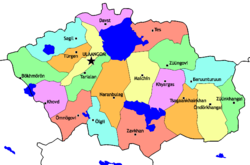Uvs Province
Uvs Province | |
|---|---|
 | |
 | |
| Coordinates: 49°30′N 92°30′E / 49.500°N 92.500°E | |
| Country | Mongolia |
| Established | 1931 |
| Capital | Ulaangom |
| Area | |
• Total | 69,585.39 km2 (26,867.07 sq mi) |
| Population (2017) | |
• Total | 82,604 |
| • Density | 1.2/km2 (3.1/sq mi) |
| GDP | |
| • Total | MNT 694 billion US$ 0.2 billion (2022) |
| • Per capita | MNT 8,130,020 US$ 2,603 (2022) |
| Time zone | UTC+7 |
| Area code | +976 (0)145 |
| ISO 3166 code | MN-046 |
| Vehicle registration | УВ_ |
| Website | uvs |
Uvs Province (/ˈʊfs/ UUFS)[a] is one of the 21 aimags (provinces) of Mongolia. It is located in the west of the country, 1,336 kilometres or 830 miles away from the national capital Ulaanbaatar. Its capital is Ulaangom which lies 936 metres or 3,070 feet above sea level.
The province is named after Mongolia's biggest lake, Uvs Lake.
Geography
Parts of the steppe in this province are protected as the World Heritage Site Ubsunur Hollow. In the north the province borders Russia for 640 kilometres or 400 miles, whilst in the east 340 kilometres or 210 miles of border lies between Uvs and Zavkhan province. In the south and west it borders for 200 kilometres or 120 miles each of Khovd and Bayan-Ölgii provinces for. The province occupies 4.45 percent of the national territory, totalling 69,585 square kilometres or 26,867 square miles. Of the total area of the province, sixty percent belongs to the mountainous climatic zone, and forty percent to the Gobi semi-desert.
Population
Mongols and their proto-peoples have lived in the province since antiquity. Currently, 42.3% of population is Dörbet, 34.2% is Bayid and 13.6% is Khalkha. Also, there are many Tuvans, Khotons, and Kazakhs living in this province.
At the end of 2014, 20,719 households were residing in this province. 7,476 lived in the provincial center Ulaangom, 4,105 lived in sum centers, and 9,138 lived in the countryside as herding families.[2]
History
After the Mongolian Revolution of 1921, the government founded the Jewel Mountain Province (Mongolian: Чандмань уулын аймаг, romanized: Chandmani uuliin aimag, pronounced [ˈt͡ɕʰantmæɲ ˈʊːɮiŋ ˈæˑməq]). This province included the whole western part of the country. In 1931 it was split into the Khovd and Dörvöd aimags—the latter which was renamed Uvs aimag in 1933.
Administrative subdivisions
Uvs province is divided into 19 sums, lower administrative division units.

| Sum | Mongolian | Population 2003 |
Population 2014 |
|---|---|---|---|
| Baruunturuun | Баруунтуруун | 3,241 | 2 449 |
| Bökhmörön | Бөхмөрөн | 2,261 | 2 093 |
| Davst | Давст | 1,854 | 1 570 |
| Khovd | Ховд | 2,463 | 2 237 |
| Khyargas | Хяргас | 2,491 | 2 314 |
| Malchin | Малчин | 2,938 | 2 351 |
| Naranbulag | Наранбулаг | 4,881 | 4 021 |
| Ölgii | Өлгий | 2,629 | 2 147 |
| Ömnögovi | Өмнөговь | 4,335 | 4 192 |
| Öndörkhangai | Өндөрхангай | 3,588 | 3 031 |
| Sagil | Сагил | 2,245 | 2 201 |
| Tarialan | Тариалан | 5,137 | 3 714 |
| Tes | Тэс | 6,014 | 5 056 |
| Tsagaankhairkhan | Цагаанхайрхан | 2,598 | 2 011 |
| Türgen | Түргэн | 1,867 | 2 018 |
| Ulaangom[1] | Улаангом | 26,940 | 27 849 |
| Zavkhan | Завхан | 2,261 | 1 734 |
| Züüngovi | Зүүнговь | 2,644 | 2 640 |
| Züünkhangai | Зүүнхангай | 2,725 | 2 104 |
| Total population | 87 592 | 75 737 |
^1 Ulaangom is the Uvs province center.
Livestock
| Year | Total | Camels | Horses | Cows | Sheep | Goats |
|---|---|---|---|---|---|---|
| 2000 | 1,579,318 | 18,235 | 74,852 | 105,737 | 858,613 | 521,881 |
| 2010 | 1,619,312 | 14,519 | 59,718 | 84,378 | 776,925 | 683,772 |
| 2014 | 2,561,315 | 19,511 | 88,408 | 145,440 | 1,260,522 | 1,047,434 |
Source: National Statistical Office of Mongolia[3]
Notes
- ^ Mongolian: Увс аймаг, romanized: Ubhs aimag, IPA: [ʊɸs ˈæe̯mə̆q]; Oirat: Увс әәмг, romanized: Uws äämg, pronounced [ʊɸs‿ˈɛːmə̆q]
References
- ^ "GROSS DOMESTIC PRODUCT, by region, aimags and the Capital". www.1212.mn. Mongolian Statistical Information Service. Retrieved 2023-12-06.
- ^ The National Statistical Office of Mongolia, http://uvs.nso.mn/page/280
- ^ The National Statistical Office of Mongolia, www.uvs.nso.mn



